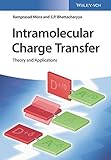Intramolecular Charge Transfer : Theory and Applications / Ramprasad Misra and S.P. Bhattacharyya.
Material type: TextPublisher: Weinheim, Germany : Wiley-VCH Verlag, 2018Description: 1 online resource : illustrationsContent type:
TextPublisher: Weinheim, Germany : Wiley-VCH Verlag, 2018Description: 1 online resource : illustrationsContent type: - text
- computer
- online resource
- 9783527801947
- 3527801944
- 9783527801916
- 352780191X
- 539.7 23
- QC173
Includes bibliographical references and index.
Vendor-supplied metadata.
Cover; Title Page; Copyright; Contents; Preface; Chapter 1 Introduction; 1.1 An Overview of the ICT Process; 1.2 Experimental and Theoretical Studies of the ICT Process; 1.3 Applications of ICT Molecules; References; Chapter 2 Brief History of ICT Molecules; 2.1 Introduction; 2.2 Background of Studies on Charge Transfer; 2.3 A Brief Review of ICT Process in Commonly Studied Organic Molecules; 2.3.1 ICT in 4â#x80;#x90;N, Nâ#x80;#x90;Dimethylaminobenzonitrile and Related Molecules; 2.3.2 ICT in Some Commonly Studied Organic Molecules; 2.4 Structure of the ICT State: Twisted or Not?
2.5 Throughâ#x80;#x90;Space Charge Transfer2.6 Charge Transfer in Inorganic Complexes; 2.7 Electron Transfer in Biomolecules; References; Chapter 3 New Theoretical and Experimental Techniques for Studying the ICT Process; 3.1 Introduction; 3.2 Computational Studies on ICT; 3.3 Theoretical Treatment of ICT Rates; 3.4 Experimental Methods for Studying ICT Process; 3.4.1 Steadyâ#x80;#x90;State UVâ#x80;#x93;Visible Absorption and Emission Spectroscopy; 3.4.2 Timeâ#x80;#x90;Resolved Ultrafast Spectroscopic Techniques; 3.4.3 Raman/Resonance Raman Spectroscopy; 3.4.4 THz Spectroscopy and ICT Dynamics; References.
Chapter 4 Medium Effect on ICT Process: Theory and Experiments4.1 Introduction; 4.2 Some Theories and Models of Solvation; 4.3 Effect of Solvent Polarity, Viscosity, and Temperature in the ICT Process; 4.4 Studies of Solvation in Some ICT Molecules; 4.5 Effect of Hydrogen Bonding on ICT; 4.6 Resonanceâ#x80;#x90;Assisted Hydrogen Bonding (RAHB); 4.7 Studies of ICT in Solvent Mixture and Confined Media; 4.8 Studies of ICT in the Solid State; References; Chapter 5 Nonlinear Optical Response of ICT Molecules; 5.1 Introduction; 5.2 The NLO Response to Electric Field.
5.3 Theoretical Calculation of NLO Response of ICT Molecules5.4 Studies of Twoâ#x80;#x90;Photon Absorption; 5.5 Thirdâ#x80;#x90;Order NLO Response of ICT Molecules; 5.6 Experimental Studies on Nonlinear Optical Response; 5.7 Studies of NLO Molecular Switches; References; Chapter 6 Recent Technological Applications of ICT Molecules and Prospect of Designing New Molecules; 6.1 Introduction; 6.2 Application of ICTâ#x80;#x90;Based Molecules; 6.2.1 ICT Molecules as Fluorescence Sensors; 6.2.2 In Organic Lightâ#x80;#x90;Emitting Diodes; 6.2.3 In Aggregationâ#x80;#x90;Induced Emission; 6.2.4 Solar Energy Conversion.
6.2.5 ICTâ#x80;#x90; Based Molecules for Sensing TemperatureReferences; Chapter 7 Summary and Outlook; 7.1 Introduction; 7.2 Summary of Studies of ICT; Further Readings; Index; EULA.
Bridging the gap between the multitude of advanced research articles and the knowledge newcomers to the field are looking for, this is a timely and comprehensive monograph covering the interdisciplinary topic of intramolecular charge transfer (ICT).The book not only covers the fundamentals and physico-chemical background of the ICT process, but also places a special emphasis on the latest experimental and theoretical studies that have been undertaken to understand this process and discusses key technological applications. After outlining the discovery of ICT molecules, the authors go on to discuss several important substance classes. They present the latest techniques for studying the underlying processes and show the interplay between charge transfer and the surrounding medium. Examples taken from nonlinear optics, viscosity and polarity sensors, and organic electronics testify to the vast range of applications.The result is a unique information source for experimentalists as well as theoreticians, from postgraduate students to researchers.
There are no comments on this title.
